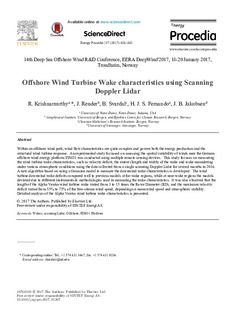| dc.contributor.author | Krishnamurthy, Raghavendra | |
| dc.contributor.author | Reuder, Joachim | |
| dc.contributor.author | Svardal, Benny | |
| dc.contributor.author | Fernando, Harindra Joseph S. | |
| dc.contributor.author | Jakobsen, Jasna Bogunovic | |
| dc.date.accessioned | 2018-08-31T11:37:16Z | |
| dc.date.available | 2018-08-31T11:37:16Z | |
| dc.date.created | 2018-01-08T22:25:15Z | |
| dc.date.issued | 2017-10 | |
| dc.identifier.citation | Krishnamurthy, R. et al. (2017) Offshore wind turbine wake characteristics using scanning doppler lidar. Energy Procedia. 137, pp. 428-442. | nb_NO |
| dc.identifier.issn | 1876-6102 | |
| dc.identifier.uri | http://hdl.handle.net/11250/2560286 | |
| dc.description.abstract | Within an offshore wind park, wind flow characteristics are quite complex and govern both the energy production and the structural wind turbine response. An experimental study focussed on assessing the spatial variability of winds near the German offshore wind energy platform FINO1 was conducted using multiple remote sensing devices. This study focuses on measuring the wind turbine wake characteristics, such as velocity deficit, the extent (length and width) of the wake and wake meandering under various atmospheric conditions using the data collected from a single scanning Doppler Lidar for several months in 2016. A new algorithm based on using a Gaussian model to measure the downwind wake characteristics is developed. The wind turbine downwind wake deficits compared well to previous models at far-wake regions, while at near-wake regions the models deviated due to different instruments & methodologies used in measuring the wake characteristics. It was also observed that the length of the Alpha Ventus wind turbine wake varied from 3 to 15 times the Rotor Diameter (RD), and the maximum velocity deficit varied from 55% to 75% of the free-stream wind speed, depending on mean wind speed and atmospheric stability. Detailed analysis of the Alpha Ventus wind turbine wake characteristics is presented. | nb_NO |
| dc.language.iso | eng | nb_NO |
| dc.publisher | Elsevier | nb_NO |
| dc.relation.uri | https://www.sciencedirect.com/science/article/pii/S1876610217353444 | |
| dc.rights | Attribution-NonCommercial-NoDerivatives 4.0 Internasjonal | * |
| dc.rights.uri | http://creativecommons.org/licenses/by-nc-nd/4.0/deed.no | * |
| dc.subject | vindturbiner | nb_NO |
| dc.subject | scanning Lidar | nb_NO |
| dc.title | Offshore wind turbine wake characteristics using scanning doppler lidar | nb_NO |
| dc.type | Journal article | nb_NO |
| dc.type | Peer reviewed | nb_NO |
| dc.description.version | publishedVersion | nb_NO |
| dc.rights.holder | © 2017 The Authors | nb_NO |
| dc.subject.nsi | VDP::Technology: 500::Environmental engineering: 610 | nb_NO |
| dc.subject.nsi | VDP::Technology: 500::Marine technology: 580::Offshore technology: 581 | nb_NO |
| dc.source.pagenumber | 428-442 | nb_NO |
| dc.source.volume | 137 | nb_NO |
| dc.source.journal | Energy Procedia | nb_NO |
| dc.identifier.doi | 10.1016/j.egypro.2017.10.367 | |
| dc.identifier.cristin | 1538326 | |
| dc.relation.project | Norges forskningsråd: 277770 | nb_NO |
| dc.relation.project | Norges forskningsråd: 193821 | nb_NO |
| cristin.unitcode | 217,8,5,0 | |
| cristin.unitname | Institutt for maskin, bygg og materialteknologi | |
| cristin.ispublished | true | |
| cristin.fulltext | original | |
| cristin.qualitycode | 0 | |

